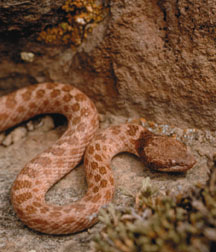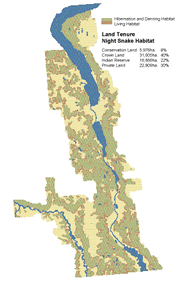|
Habitat Atlas for Wildlife at Risk
Night Snake
Hypsiglena torquata deserticola

Night
Snake
|

- Other Name: Desert Night Snake
- Length: 30 - 66 cm; small and slender-bodied
- Beige, yellowish or grey body, patterned with
dark grey-brown blotches; belly is unpatterned cream
or
white.
- Distinguished from other snakes by three long,
dark blotches along the neck, and running behind
each eye.
- Appearance similar to young rattlesnake or Gopher
Snake, except for dark neck patches.
Status:
British Columbia Red List
Special Significance
The Night Snake is the rarest snake in Canada. It is
difficult to determine the population size because
of their secretive and nocturnal nature. Despite
the fact that they are harmless to humans, they are
presumably often killed because they look very similar
to young rattlesnakes. There is little known about
these elusive creatures but it is believed they prefer
similar climate and habitat as the Western Rattlesnake.
Attempts should be made to protect den sites, and
natural habitats within one kilometre of dens, to
ensure the continued survival of these shy and vulnerable
creatures.
Distribution
- British Columbia's small population is found in Southern Okanagan
Valley and Lower Similkameen Valley.
Habitat
- Grasslands and low elevation ponderosa pine parkland likely important
foraging areas.
- Found in sandy and rocky habitats.
- Rock outcrops and cliffs provide winter dens; often
close to grassland and marsh habitats.
Reproduction
- Active from April to October.
- Females lay 2 to 9 eggs in June or July.
- Eggs are incubated for about 2 months.
Food Habits
- Diet includes frogs, lizards and their eggs and large insects.
- Immobilize prey using venom from fangs at back of upper
jaw; venom may only be toxic to frogs and lizards.
- Foraging occurs from mid-April to mid-September.
Interesting Facts
- Smallest snake in British Columbia.
- Only (mildly) venomous snake in British Columbia with
fangs at back of upper jaw.
Encounters
- When cornered, snakes may attempt to bite in defense.
- Night Snake venom is not known to be poisonous to humans.
Threats
- Extensive land development in the Okanagan has
eliminated or fragmented their habitat
(including dens and feeding grounds).
- Exploitation of talus as source of rip-rap and
fill for construction.
- Deliberate killing by humans because of resemblance
to young rattlesnake.
- Poor condition of rangeland may reduce prey availability.
- Indirectly killed on roads.
- Burning and clearing of shrubs and subsequent seeding
of non-native grass species may reduce quality
and prey availability.
Management Considerations
- Maintain habitat such as grasslands and ponderosa
pine forests.
- Discourage removal of ground debris in forested
areas and exploitation of talus.
- Conduct survey to locate den sites before surface
disturbances occur in their habitat.
- Identify and protect dens and nesting sites whenever
possible.
- Leave 1 km buffer zone around known den sites
and critical habitats.
- Avoid road construction near talus slopes and
around known snake dispersal routes.
- Maintain good range condition in grasslands
for cover and habitat for prey species.
|
References
1. Nussbaum, R.A., E. Brodie and R. Storm. 1983. Amphibians and Reptiles
of the Pacific Northwest. University of Idaho Press, Moscow, Idaho.
2. Gregory, PT and R.W. Campbell. 1984. The reptiles
of British Columbia. British Columbia Provincial Museum Handbook No.
44. Victoria, BC.
|